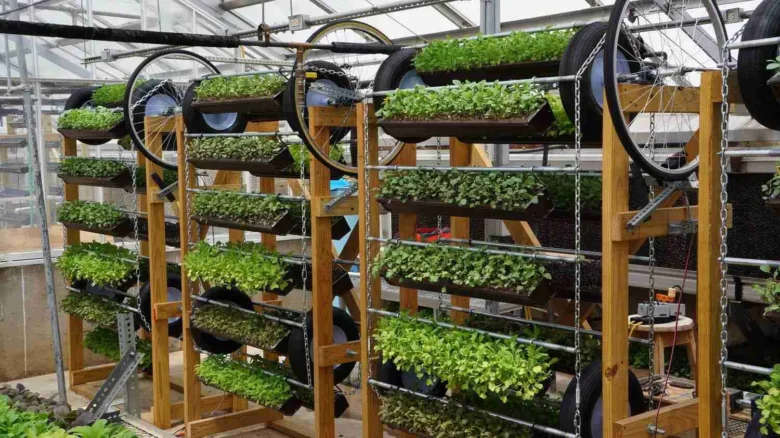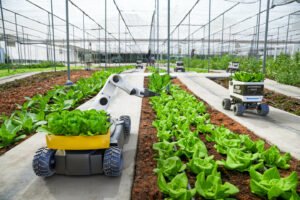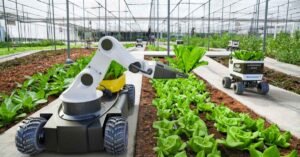Traditional farming methods are changing as people move to cities and become more concerned about the climate. This has given rise to new ideas, such as vertical farming. This revolutionary idea really took agriculture to a whole new level. This article discusses the growing trend of vertical farming at home. It discusses how it works, its benefits, and how people can start using this eco-friendly method to grow fresh food in their own homes.
Introducing the Concept of Vertical Farming:
1. Understand Vertical Farming
Vertical farming is a new way of growing food by stacking it vertically and often integrating it into urban buildings. Unlike traditional horizontal planting, this method makes optimal use of space by stacking plant beds or shelves vertically, creating a three-dimensional environment for plant growth.
2. Major Components of Vertical Farms
Plants are grown without soil via hydroponic or aeroponic methods commonly used in vertical farms. Instead, nutrient-rich water or mist goes straight to the roots of your plants, giving them what they need. Controlled environment agriculture (CEA) tools, such as climate control and artificial lighting, can improve growing conditions.
3. Benefits of Vertical Farming
- Space Efficiency: Vertical farms make the most of small areas, meaning they can be used for farming in cities where horizontal space is limited.
- Conserve Resources: A controlled environment uses less water, and landless agriculture means crops require much less space.
- Year-Round Production: Vertical farms can produce year-round, regardless of the weather outside, ensuring fresh food is always available.
How to do Vertical Farming at Home:
1. Choose the Right Crops
Choosing the right plants for your vertical farm is important. Leafy vegetables such as lettuce and spinach, as well as herbs such as basil, mint, and coriander, do well indoors. Tomatoes, strawberries, and other small fruit plants also grow well in vertical plantings.
2. Set Up a System with Water or Air
The main components of vertical farming are hydroponic and aeroponic setups. These methods deliver nutrients directly to the plant’s roots, improving absorption and accelerating growth. A simple hydroponic system is a good starting point for beginners. More experienced growers may want to look into aeroponics for more precise control.
3. When Purchasing an LED Grow Light
For vertical farming at home, you need adequate lighting, especially if you’re indoors and don’t have a lot of natural light. LED grow lights provide plants with the full range of light they need to grow and can be adjusted to suit different stages of plant development.
4. Adjust Temperature and Air Flow
Keeping the weather stable is important for the functioning of vertical farming. Controlling temperature, humidity, and airflow are all part of the equation. Automated systems with sensors can help monitor these things and create the perfect space for plants to grow.
Why Vertical Farming at Home is a Good Idea:
1. Harvest All Year Round
Home vertical farms provide people with a controlled environment in which they can grow crops year-round. This not only ensures that there is always fresh food but also reduces dependence on seasonal foods.
2. Less Harmful to the Environment
Conventional farming uses more resources than vertical gardening. Vertical farming at home has a lower impact on the planet because it uses less water, requires less land, and does not create chemical runoff.
3. Better Food Safety
People grow their own food at home, so they have enough to eat. Because it is unaffected by outside factors like transportation or supply chain issues, homegrown food is a reliable source of fresh food.
Questions and Things to Think About:
1. Initial Establishment Costs
Setting up a home-based vertical farm may cost money initially in terms of tools, lighting and systems, but the long-term benefits are enormous. But over time, the money you save on food prices can make up for these costs.
2. Technical Knowledge:
Vertical Success If you want to farm at home, you need to know the basics of plant biology, hydroponics or aeroponics, and how to use a temperature control system. People can use educational resources and community support to get the information they need.
3. Not Enough Cream
Vertical farming makes good use of space, but those without enough space may have difficulty setting up larger systems. Vertical farmhouses can be adapted to different types of living spaces, but you need to plan carefully.
Stories about Vertical Farming will Inspire You:
1. Window Grill Farm for City Apartments
Some smart people use their windows as vertical farms, hanging containers from the ceiling and growing herbs and microgreens inside. This DIY approach allows people who live in cities and don’t have much space to grow fresh food at home.
2. A Plant System with Built-In Modules
There are now modular vertical growing methods available on the market that are suitable for home use. The smart technology built into these systems allows users to monitor and control the growing environment through mobile applications.
3. Community Vertical Garden
In some communities, people have created collective vertical gardens to collectively maintain vertical farming systems. These group activities build community and help protect the environment.
Future Trends and Inventions:
1. Add Technology to Smart Homes
In the future, vertical farming at home can work better with smart home technology. Using smart devices to run automated systems can speed up the growth process and make it easier for more people to do things.
2. Advances in Plant Genetics
Plant genetics research continues with the aim of creating crops most suitable for vertical growth. Vertical farming at home can be transformed with plants that grow in tight groups, require less food, and are less likely to be infected by insects.
3. Education Plan
As vertical farming at home becomes more popular, training programmes may be launched to teach people the basics of growing plants indoors. Workshops, online courses, and community outreach programmes can help more people adopt this eco-friendly habit.
Conclusion:
When you practice vertical farming at home, agriculture and technology come together to provide sustainable answers to the problems of urban living and growing food. As people learn more about how to grow their own food, they help make the future safer and show respect for the environment. Home Vertical farming is more than just a way to grow plants; It is also a trend towards sustainability, care for the environment and healthier, greener living. By reaching for the sky, we sow the seeds of good change, one vertical garden at a time.
FAQs:
1. Which crops are suitable for vertical farming at home, and how do you choose the right one?
Herbs such as basil, mint, and coriander, as well as leafy greens such as lettuce and spinach, are all suitable for vertical farming at home. Compact fruit plants, such as tomatoes and strawberries, can also thrive in vertical systems. When choosing crops, consider factors such as available space and personal preference.
2. Can vertical farming be implemented in small living spaces, such as apartments?
Yes, vertical farming fits into small living spaces. Technologies such as window farming and compact modular systems are designed for city dwellers with limited space. Vertical farms can be adapted to different living environments.
3. What are the basic components needed to set up a vertical farm at home?
Setting up a vertical farm at home requires a hydroponic or aeroponic system for soilless growing, LED grow lights for adequate lighting, and a climate control system to regulate temperature and humidity. Component selection depends on the size and complexity of the desired setup.
4. How can vertical farming at home promote sustainability and reduce environmental impact?
Vertical farming at home promotes sustainability by minimising resource consumption. It reduces water consumption, minimises land requirements, and eliminates the need for chemical disposal. Growing produce at home also helps reduce carbon emissions associated with transportation.
5. What challenges might I face when setting up a vertical farm at home, and how can I overcome them?
Challenges in setting up a home-based vertical farm can include initial costs, the need for technical knowledge, and space limitations. Overcoming these challenges requires finding educational resources, exploring do-it-yourself solutions, and adapting vertical farming techniques to the available space.



